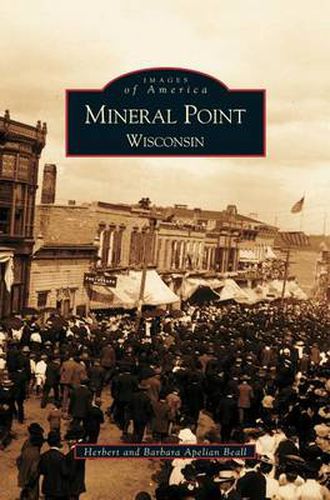Readings Newsletter
Become a Readings Member to make your shopping experience even easier.
Sign in or sign up for free!
You’re not far away from qualifying for FREE standard shipping within Australia
You’ve qualified for FREE standard shipping within Australia
The cart is loading…






This title is printed to order. This book may have been self-published. If so, we cannot guarantee the quality of the content. In the main most books will have gone through the editing process however some may not. We therefore suggest that you be aware of this before ordering this book. If in doubt check either the author or publisher’s details as we are unable to accept any returns unless they are faulty. Please contact us if you have any questions.
Mineral Point, Wisconsin, recounts the changing fortunes of a once rough-and-ready mining town of the 1820s. Featuring historic photographs from the collection of the Mineral Point Historical Society and Pendarvis-Wisconsin State Historic Site-an exciting history unfolds in these pages, with the arrival of miners from the fledgling United States in the 1820s in search of lead. When the demand for lead collapsed, Mineral Point shifted its focus to the mining of zinc, only to have that market drop after World War I. Mineral Point was reawakened in the 1930s with the influx of artists and others, like Edgar Hellum and Robert Neal, who were interested in historic preservation. The town has transformed itself once again, becoming a vibrant artistic, historic, and architectural center. In 1971, it became the first Wisconsin community to be placed on the National Register of Historic Places, with 514 contributing buildings. This fascinating pictorial history celebrates the people of Mineral Point-the early American settlers from Missouri, Illinois, and Kentucky, and the Cornish, German, Irish, and Italian immigrants. Mineral Point, Wisconsin, also features their legacy-their homes, businesses, schools, and organizations. These historic photos provide glimpses of the extensive zinc works that no longer exist, as well as many of the buildings still standing in the town today.
$9.00 standard shipping within Australia
FREE standard shipping within Australia for orders over $100.00
Express & International shipping calculated at checkout
This title is printed to order. This book may have been self-published. If so, we cannot guarantee the quality of the content. In the main most books will have gone through the editing process however some may not. We therefore suggest that you be aware of this before ordering this book. If in doubt check either the author or publisher’s details as we are unable to accept any returns unless they are faulty. Please contact us if you have any questions.
Mineral Point, Wisconsin, recounts the changing fortunes of a once rough-and-ready mining town of the 1820s. Featuring historic photographs from the collection of the Mineral Point Historical Society and Pendarvis-Wisconsin State Historic Site-an exciting history unfolds in these pages, with the arrival of miners from the fledgling United States in the 1820s in search of lead. When the demand for lead collapsed, Mineral Point shifted its focus to the mining of zinc, only to have that market drop after World War I. Mineral Point was reawakened in the 1930s with the influx of artists and others, like Edgar Hellum and Robert Neal, who were interested in historic preservation. The town has transformed itself once again, becoming a vibrant artistic, historic, and architectural center. In 1971, it became the first Wisconsin community to be placed on the National Register of Historic Places, with 514 contributing buildings. This fascinating pictorial history celebrates the people of Mineral Point-the early American settlers from Missouri, Illinois, and Kentucky, and the Cornish, German, Irish, and Italian immigrants. Mineral Point, Wisconsin, also features their legacy-their homes, businesses, schools, and organizations. These historic photos provide glimpses of the extensive zinc works that no longer exist, as well as many of the buildings still standing in the town today.